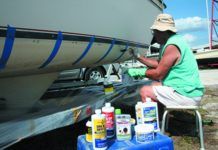Finding Splicing Instructions
Your PS Advisor on rope lifeline terminals [March] is right on time for the refurb of my Pearson 35. The key issue is how to execute your high-tech ropework splice. As the education officer of the Dundalk Sail and Power Squadron I have been asked on several occasions to have a marlinespike training session. Where can I get some instructions on how to work with high-modulus materials?
-Raymond M. Schiff
Baltimore, MD
We referred your question to Brion Toss even before we got started on some seizing and splicing projects ourselves (see editorial). And his response came through just as we reached full stymie. It’s a small measure of comfort.
Here’s Brion:
“First, yes you can get instructions from manufacturers, and that’s how I started out. But the primary reason that people avoid splicing this stuff is…instructions from manufacturers. As in too confusing, too complicated, too difficult. We hear this all the time from people, and having slogged through countless bizarre manuals, I sympathize. Some instructions are better than others-New England Ropes’ are not too horrid.
“I have a vested interest in saying this, but we get much positive feedback from our video on splicing, and the instructions in The Rigger’s Apprentice. You might ask a more impartial person or persons about this.
“Further option: in our ongoing effort to make this stuff simple enough for sailors, we are working on (yet another) knot book, which will focus on practical applications for contemporary vessels. That’s right, instead of just a compendium of complications, we hope to show the knots and splices that people really need, in this particular century. And the splice instructions will be the simplest, hardest-to-screw-up ones in print, anywhere.”
Brion, may your publishers hasten their labors.
We, too, find manufacturers’ instructions lacking in clarity, although a splice is never easy to describe, either in words or still pictures.
It used to be that if you blindly and exactly followed, for example, Samson’s instructions for an eye splice in double braid, you’d make a good splice. It would seem slightly miraculous, as you milked the cover down over the last of the core, but eventually, if you did it enough, it got to be as familiar as making a three-strand eye-splice. The same thing will happen with core-to-core splices in the high-tech line. We have faith. But we’re on the lookout for the best instructions, and will pass them along to you eventually. Meanwhile, visit www.briontoss.com.
———-
Gelcoat Repair
It is finally spring! I have removed the cover on my 1987 Hunter 40′ and am preparing to paint the bottom.
I have three or four places that the gelcoat is cracked. One place looks like a jetski hit me on my mooring. It’s about 6-8″ above waterline. What should I use to repair the small hull areas?
-Neil Thompson
Massapequa Park, NY
Attacked by a giant water gnat. If only there were a pesticide…
Assuming that your Hunter is white, or at least not of a faded or obscure color, try out one of the gelcoat repair kits we reviewed in the August 15, 2001 issue. The Sea Fit (West Marine) and Evercoat kits were virtually identical, and pretty good, but we found the kit made by Bondo (www.bondo.com) to be a better value, and tied for best (with the large SeaFit kit) in visual appeal.
In gelcoat repair, that corollary to the Hippocratic Oath applies: “First of all, do no harm.” If at all possible, take a practice run on some gelcoat less dear to your heart.
———-
Rust Removal
I have copies of PS since 1993. Could you send me any information regarding removal of rust from stainless steel- i.e. stanchions, uprights, radar poles, and so on? I would appreciate learning the date if you indeed did review such a product.
-A.J.Beland
Via e-mail
Just missed you-it was in the February 15, 1993 issue that we tried MDR Rust-Away and Duro Naval Jelly Rust Remover. The subject was a rusty trailer jack. We found that neither product worked particularly well in that situation, but that the Duro Naval Jelly would do a reasonable job of removing light rust without tarnishing-it was better than the MDR. The Duro contains phosphoric acid.









































